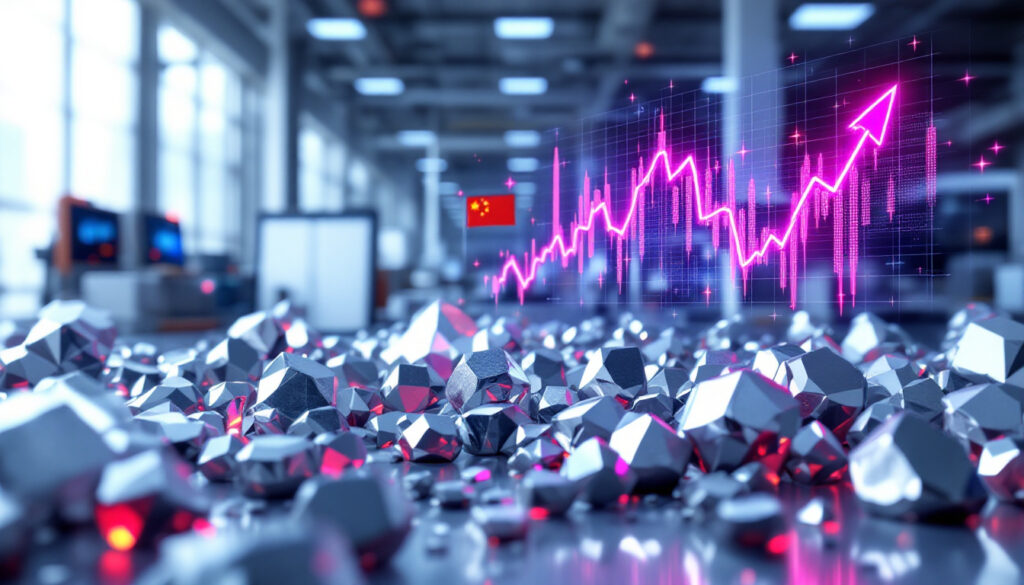Understanding Germanium Price Corrections in China
In a rare instance highlighting the precision required in commodity pricing, Fastmarkets recently issued an important correction to its germanium price assessment in China. The correction, which adjusted a significant typographical error, demonstrates the critical nature of accurate price reporting in specialized metals markets where even small errors can have outsized impacts on global trade and contracts.
The germanium price correction specifically addressed the MB-GER-0004 assessment for high-purity germanium (99.999% Ge min) in the Chinese warehouse market. Initially published at 16,000-168,000 yuan per tonne on April 18, 2025, the actual intended range was 16,000-16,800 yuan per tonne – revealing a tenfold error in the upper range that could have significantly misled market participants.
Within three business days, by April 21, 2025, Fastmarkets had identified, verified, and corrected the error across all its pricing databases and published platforms, demonstrating the company's adherence to international price reporting standards.
What Happened with the Germanium Price Correction?
The specific error involved a simple yet potentially consequential typographical mistake. When publishing the MB-GER-0004 price assessment for germanium in China, Fastmarkets erroneously reported the high end of the price range as 168,000 yuan per tonne when the actual assessed value was 16,800 yuan per tonne.
In commodity markets where participants often execute multi-million dollar contracts based on published price assessments, such a discrepancy could have created significant market dynamics insights. The error represented a 10x inflation of the upper price boundary, which in germanium markets – where supply chains are particularly sensitive to price signals – could have triggered unwarranted alarm among buyers.
The timeline of events followed Fastmarkets' established correction protocol. The error appeared in publications dated April 18, 2025. Internal verification processes flagged the discrepancy, and by April 21, 2025, a formal correction notice was issued. Simultaneously, all pricing databases were updated to reflect the accurate assessment, ensuring the integrity of historical data for future reference and contract settlements.
"Market transparency requires accountability," noted a Fastmarkets statement accompanying the correction. "Our price reporting infrastructure includes multiple verification stages specifically designed to identify and promptly address such discrepancies."
How Germanium Pricing Works in China
Understanding germanium price assessments requires familiarity with the specific methodology that price reporting agencies employ. The MB-GER-0004 assessment represents a particular specification: germanium with minimum 99.999% purity (often referred to as "five-nines" in industry terminology) available from warehouses within mainland China.
The price is assessed in Chinese yuan per kilogram, reflecting the local market conditions where most of the world's germanium is produced. China dominates global germanium production, accounting for approximately 65-70% of worldwide supply. This concentration makes Chinese pricing particularly influential for global markets.
Fastmarkets incorporates this assessment within its minor metals package – a collection of specialized metal markets that, while smaller in trading volume than base metals like copper or aluminum, serve critical functions in high-technology applications. The assessments combine direct transaction data, bids, offers, and market participant feedback to arrive at representative price ranges.
Germanium pricing operates differently from exchange-traded metals. Rather than continuous trading with moment-by-moment price discovery, these specialist markets rely on price reporting agencies to provide transparent, methodologically sound assessments that reflect actual trading conditions in relatively opaque markets.
The frequency of assessment considers market liquidity, with germanium prices typically assessed weekly rather than daily, acknowledging the lower transaction volume compared to major industrial metals.
Why Do Price Corrections Matter in Commodity Markets?
Accurate price reporting forms the backbone of functioning commodity markets, particularly for specialized materials like germanium that lack the transparency of exchange trading. Market participants – from miners and refiners to component manufacturers and end-users – rely on published price assessments for numerous critical functions.
"The integrity of minor metals markets depends on reliable price benchmarks," explains industry consultant Wei Chen in Fastmarkets' methodology documentation. "Unlike copper or aluminum with transparent exchange pricing, contract negotiations for germanium and similar specialty metals often reference third-party assessments directly."
Price reporting agencies like Fastmarkets operate under guidelines established by the International Organization of Securities Commissions (IOSCO), which mandates principles for benchmarks used in financial markets. These principles require transparent methodologies, robust governance structures, and explicit procedures for handling corrections when errors occur.
The economic impact of pricing errors can be substantial. Contract settlements, inventory valuations, and investment strategies all rely on accurate price data. For example, a contract linked to germanium pricing might specify settlement at "Fastmarkets' MB-GER-0004 assessment plus $X premium" – meaning any error in the base assessment directly affects payment obligations.
Corporate compliance teams increasingly scrutinize price assessment methodologies as part of supply chain due diligence, particularly for minerals like germanium that face growing regulatory attention related to critical mineral supplies and technology security concerns.
How to Provide Feedback on Price Assessments
Market participation remains essential to accurate price assessments. Fastmarkets and similar price reporting agencies actively solicit market feedback through established channels to ensure their methodologies and specific assessments reflect genuine trading conditions.
For the germanium market specifically, feedback can be directed to the responsible price reporter – currently Nico Zhang, according to Fastmarkets documentation. Formal feedback submissions should be sent via email to pricing@fastmarkets.com with a subject heading clearly indicating "FAO: Nico Zhang" to ensure proper routing.
Companies active in the germanium market can become regular data submitters, providing information on actual transactions, bids, and offers under confidentiality protocols that protect commercially sensitive details while contributing to market transparency.
Fastmarkets maintains a structured approach to market comments and feedback, distinguishing between methodology suggestions (which undergo formal review processes) and specific assessment feedback (which may trigger verification procedures for individual price points).
Beyond direct feedback channels, Fastmarkets conducts regular methodology reviews with public consultation periods, allowing market participants to influence how assessments are conducted. These reviews typically occur annually unless market conditions warrant more frequent examination.
FAQ: Germanium Pricing in China
What is germanium and what are its main applications?
Germanium is a semiconducting element (atomic number 32) classified as a technology-critical element due to its specialized applications. Though relatively scarce in the Earth's crust at about 1.5 parts per million, it has become increasingly important in high-technology applications.
The primary applications driving germanium demand include:
- Fiber optic systems (approximately 30-35% of consumption), where germanium dioxide is used as a dopant in optical fiber core glass to control refractive index
- Infrared optical technologies (25-30%), including night vision systems, thermal imaging, and specialized lenses
- Polymerization catalysts (15-20%), particularly in PET plastic production
- Solar cell applications (10-15%), especially in high-efficiency multi-junction cells for spacecraft and concentrated photovoltaics
- Emerging applications in quantum computing and spintronics research
These specialized applications make germanium pricing particularly sensitive, as substitution often proves technically challenging when price volatility occurs.
How often are germanium prices assessed in China?
Fastmarkets assesses germanium prices in China on a weekly basis, typically publishing updated assessments each Friday. This frequency balances the need for current market information against the reality of relatively limited transaction volume in specialty metals markets.
The assessment schedule considers holidays, with no assessments published on UK or Chinese public holidays. When holidays fall on assessment days, Fastmarkets either publishes early or delays until the next business day, depending on market conditions and participant availability.
Market participants should note that while weekly assessments represent the standard frequency, Fastmarkets reserves the right to produce special assessments outside the regular schedule during periods of exceptional market volatility or significant disruption. Such instances are clearly communicated to subscribers.
What factors influence germanium pricing in the Chinese market?
Several interrelated factors drive germanium prices in China, creating a complex market dynamic:
Supply-side factors:
- Production costs at primary zinc mines (germanium is primarily recovered as a byproduct of zinc processing)
- Recycling rates from end-of-life products, particularly military optics and fiber optic systems
- Environmental compliance costs at processing facilities, which have increased substantially under China's enhanced environmental regulations
- Production quotas and operational restrictions (particularly in provinces implementing periodic industrial production limits)
Demand-side factors:
- Fiber optic network expansion projects in developing markets
- Military procurement cycles for infrared optical systems
- Solar installation growth rates in high-efficiency applications
- Technology transitions in semiconductor applications
Regulatory influences:
- Export license approvals through MOFCOM (China's Ministry of Commerce)
- Strategic resource classifications affecting production permits
- International trade tensions impacting high-technology supply chains
- Environmental compliance requirements affecting production facilities
Market structure elements:
- High concentration of production among relatively few producers
- Limited spot market liquidity compared to major industrial metals
- Stockpiling behavior by both government and private entities
- Long-term contract structures that may limit price transparency
The interplay between these factors creates a market where price assessment accuracy is particularly valuable, as participants have limited alternative price discovery mechanisms.
How can market participants verify price information?
Market participants seeking to verify germanium price assessments have several options for validation and comparison:
Fastmarkets provides detailed methodology documentation explaining how assessments are conducted, including specifications for material quality, delivery terms, payment conditions, and benchmark assessment guidelines. These methodologies undergo regular review and consultation with market participants.
Historical price data access requires subscription to Fastmarkets' minor metals package, which provides not only current assessments but also comprehensive price analysis enabling context and pattern recognition. Statistical tools within the platform allow users to analyze price movements, volatility, and correlation with related markets.
For independent verification, participants can compare assessments across multiple price reporting agencies, though methodological differences must be considered when making direct comparisons. Alternative sources include Asian Metal, Argus Media, and CRU Group, each with somewhat different assessment approaches.
Industry associations like the Minor Metals Trade Association (MMTA) provide additional context through market reports and conference presentations, though they typically do not publish competing price assessments.
The most robust verification comes from active market participation – companies regularly engaging in germanium transactions develop internal price benchmarks against which third-party assessments can be evaluated. This "ground truth" represents the ultimate reality check for published price data.
Germanium's growing importance in critical technologies and China's dominant position in production make accurate price assessment particularly valuable for global commodity insights and technology supply chains, highlighting why corrections to germanium pricing in China, when needed, must be implemented promptly and transparently.
Ready to Capitalise on the Next Major Minerals Discovery?
Stay ahead of market movements with Discovery Alert's proprietary Discovery IQ model, which instantly notifies investors about significant ASX mineral discoveries, turning complex mineral data into actionable opportunities. Explore why historic discoveries have generated substantial returns by visiting the Discovery Alert discoveries page and begin your 30-day free trial today.




